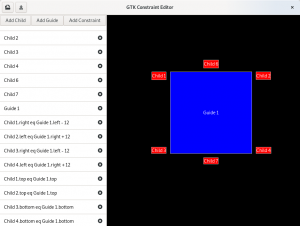A few days ago, I’ve released a GTK 3.98 tarball. This is another step towards GTK 4. It is a little bit behind schedule, and does not quite include all the things we wanted to get into it, but it gets a lot closer to what we want to ship in GTK 4.
Almost 9 months have passed since the 3.96 snapshot, so there are quite a few new things to look at. Too many to cover them all, but here are some highlights:
Performance
The GL renderer has seen a steady flow of optimizations and performance improvements.
After the Westcoast hackfest last year, the GtkTextView scrolling performance has been greatly improved by making it cache render nodes for the visible range. At the same hackfest, the text caret blinking was changed to be smoothly animated, which is not relevant for performance at all, but looks cool.
Since the new year, a big focus has been on improving the performance of the CSS machinery. The CSS value implementation has been optimized to avoid computing values whenever possible. CSS lookups are using a Bloom filter now. And the IO for icon loading has been moved to a thread.
Most of the recent work was made possible by the sysprof profiling support that was added after the performance hackfest, and has recently been enhanced to report more information. To use it, simply start a GTK application with GTK_TRACE=1 in the environment, and load the resulting syscap file with sysprof.
DND
The DND refactoring has been completed. The GTK API for DND has been turned into event controllers: GtkDragSource and GtkDropTarget. Support for file transfers via file transfer portal has been added for both DND and the clipboard. The underlying new infrastructure for data transfers has been covered in detail before.
GDK
The move of GDK towards Wayland concepts is continuing. This cleanup is not 100% complete yet.
Child surfaces have been removed. GDK only supports toplevel and popup surfaces now. The client-side window implementation has been removed too. Global positions and related APIs such as gdk_surface_move() are no longer available.
Grabs are no longer exposed as API. As a replacement, popup surfaces can be configured to hide on outside clicks.
XI2 is now mandatory when building the X11 backend, and support for the xim input method has been removed in favor of IBus.
The Wayland backend no longer relies on libwayland-cursor to load cursor themes, and loads individual cursors on demand.
GTK removals
Many classes have been made explicitly non-subclassable, and the widget hierarchy has been simplified, by making widgets derive directly from GtkWidget where possible.
GtkMenu, GtkMenuBar, GtkToolbar and related classes have been removed. They are being replaced by GMenu and popover-based variants. Popover menus can now do traditional, nested menus, and also show accelerators.
Context menus are no longer created with ::populate-popup signals, but also use menu models and actions. Creating those actions has been made easier with APIs like gtk_widget_class_install_action(), to create them in class_init.
GtkGestureMultiPress has been renamed to GtkGestureClick, to make it more obvious what this event controller is for.
GTK additions
We did not just remove things. Some new things have been added too.
The GtkNative interface has been introduced for widgets that have their own surface. This has been split off from the GtkRoot interface, which is exclusively for toplevel widgets without a parent.
A constraint-based layout manager has been added. It would be great to see people try this out. Please give us feedback if you do.
GtkTextView and other text widgets have gained a simple undo stack that can be used with Ctrl-Z.
The Emoji chooser widget has been made public.
Whats ahead
After 3.98, I’m planning to do more frequent snapshots, as the remaining outstanding items are landing. What are those items, you are asking ?
Here are the things that we still want to integrate before GTK 4:
– Event controllers for keyboard shortcuts
– Movable popovers
– Row-recycling list and grid views
– Revamped accessibility infrastructure
– Animation API










